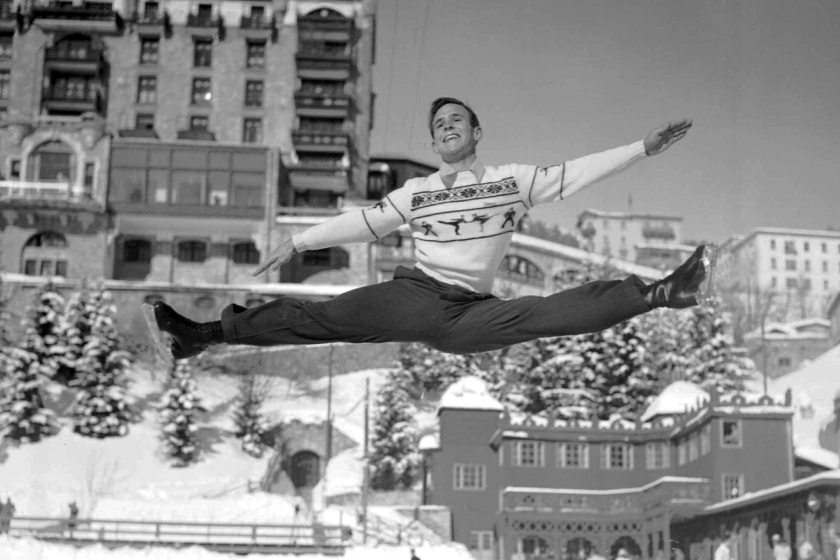Skating After a New Set of Figures : Fledgling Professional Competitions Give Kravette’s Career a Fresh Start
- Share via
For most young female skaters, there are only two role models--Katarina Witt and Snoopy.
Or both.
You first step on the ice as a toddler, give up your childhood to skate from dawn’s early light winter and summer, and your family gives up a lot of luxuries to keep you stocked in skates and lessons.
For what?
For the dream that somehow, some day, you might be 1 of the 3 American girls selected every 4 years to go to the Olympics.
And beyond that, that you might be good enough to finally make some money out of this lifelong pursuit by getting the chance to perform in one of the big ice shows as Snoopy or Tinker Bell or one of the other colorful characters in the cast.
But don’t bet on it. We’re talking less than 1 percent of all skaters here.
Aimee Kravette would like to see that change.
The Sherman Oaks resident, though not a household name like Witt or Debi Thomas, already has skated further down that path to glory than most.
She laced on her first pair of skates before she was 3 years old back home in New Jersey, went through years and tears of hard work and made it all the way to the U. S. nationals in 1980, where she finished seventh, falling 4 places short of an Olympic berth.
“I made all the sacrifices,” Kravette said, “the whole dramatic story. I dreamed of the Olympics as everyone does.
“But I was 18 by 1980 and it was expensive to keep on skating. If it didn’t look like you were going to make it four years later, you might as well forget it. And it didn’t look like I would. So continuing was irrelevant. Besides, I wanted to skate in shows.”
That she did.
Kravette went on to perform in Ice Capades, at Radio City Music Hall in New York, locally at Knott’s Berry Farm and as a double for a skater in the movie Flashdance. She also gives private lessons at the Ice Capade Chalet in North Hollywood.
But the competitive juices never stopped flowing. And recently, after 8 years, she finally got her chance to put them to use once again.
A world championship event for professionals was being held in Jaca, Spain. Kravette admitted that, normally, she wouldn’t have tried to qualify for such a competition.
“I was scared that I would not be chosen,” she said. “After all, I had not skated competitively since 1980.”
But in this case, that was not necessary. Applicants for the American contingent were being chosen on the basis of videotapes of previous performances.
“I figured, why not?” Kravette said. “It didn’t cost anything.”
Not only that, but it paid off. Kravette was selected and on her way to Spain, where she finished third overall out of 4 Americans in the top 12.
Having gotten her skates wet, she competed last weekend in the United States Open professional figure skating event in Florida and again finished third, qualifying for a return trip to Spain next year.
The Florida event was sponsored by the Professional Skaters Guild of America, an organization 1,200 strong that is promoting the idea of giving skaters the opportunity to continue competing beyond their amateur days.
There is still a way to go in that regard. The U. S. Open, begun in 1980, has not been held in 3 of the past 8 years because of financial problems. This year, the skaters were told it would be held in Orlando. But on arrival, they found it had been switched to Daytona Beach because of problems with the site.
And then there is the matter of prize money, still not exactly what one might find at the U. S. Open for, say, tennis or golf. Far from it. Kravette pocketed $2,700 for finishing third in Spain. And for that, she had to pay part of her own traveling expenses.
Kravette had to pay her own way to Florida, too, where her third-place finish was worth just $1,000, not even a break-even proposition. It’s not much better at the top. First place in Florida was worth $5,000, in Spain $4,000.
“I wish they had started something like this a long time ago,” Kravette said. “I’m coming to the end, age-wise, of where I can skate. Now there is a much brighter future for skaters.
“There are different types of shows today. Before it was either get hired by Ice Capades or Ice Follies or do nothing. Now there are smaller shows that are more creative and more competition for professionals.”
Earlier this week, 1988 Olympic gold medalists Witt and Brian Boitano had a network skating show in prime time.
“That’s something you just wouldn’t have seen 10 years ago,” Kravette said. “There’s more interest and more opportunity everywhere. Before, there were only three girls selected for the Olympics every four years. For everybody else, it was just a dream.”
More to Read
Go beyond the scoreboard
Get the latest on L.A.'s teams in the daily Sports Report newsletter.
You may occasionally receive promotional content from the Los Angeles Times.






